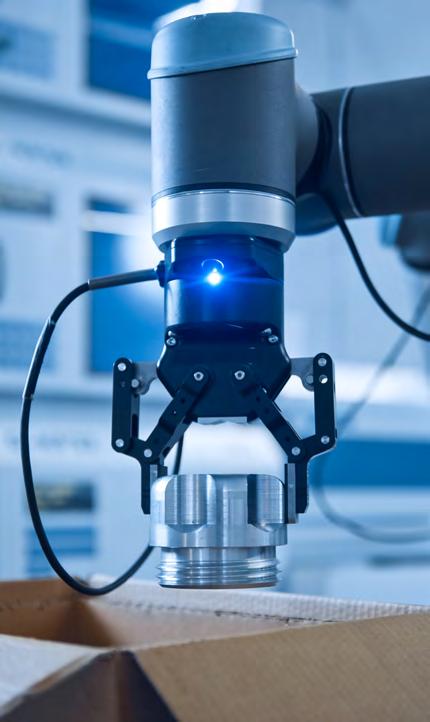
4 minute read
FORECAST
WAREHOUSE AUTOMATION MARKET
GREW 28% IN 2021 BUT WILL THE GOOD TIMES LAST?
Rowan Stott, a Research Analyst at Interact Analysis, presents an acute report on how warehouse automation is forecasted to perform in the near future
Rawan has an academic background in physics and experience in experimental environments and works in the automation sector. While he has a keen interest in micro-fulfilment, rapid delivery and last-mile logistics, he is also helping expand Interact Analysis’ research coverage in this fastgrowing industry.
Following the publication of our Warehouse Automation – 2022 report, we have produced this insight to discuss the major themes which have influenced the forecast. The report provides a highly granular assessment of the market and factors in many nuances. This insight, therefore, intends to provide a top-level summary of the key trends. COVID-Fuelled Growth The warehouse automation market grew by a phenomenal 28% in 2021, with revenues reaching $36 billion, up from $28.5 billion in 2020. The growth of automation revenues in 2021 was driven mainly by the e-commerce spike caused by the pandemic. According to FRED, US E-commerce penetration peaked at 16.4% in 2020, rising from 10% in Q1 2019. To service this increase in e-commerce demand, we saw several retailers bolstering their fulfilment capacity. For example, according to its annual reports, Amazon’s total warehouse square footage ballooned from 272 million at the end of 2019 to 525 million at the end of 2021.
Because automation is often used in fulfilment centres due to the complexity of the operation, we saw warehouse automation investments spike during the pandemic as retailers rapidly expanded their fulfilment capacity. Amazon led the charge in automation investments, accounting for more than 30% of total automation investments in the US in 2021.
The pandemic also significantly impacted commodity prices, which skyrocketed in 2020. Steel prices, for example, had more than tripled by the end of 2021 compared to pre-pandemic levels, while the cost of electronic components also increased significantly due to supply-chain constraints and poor demand forecasting. The cost of steel can make up to 80% of the value of some automated systems like unit-load AS/RS, which meant that automation increased significantly during the pandemic.
Lastly, the early lockdowns resulted in many companies having artificially low revenues in 2020 as project completion dates were pushed back into 2021. Knapp, for example, suffered a -1.8% decrease in revenues in 2020, despite a 55% increase in order intake. This revenue ‘push-back’ led to somewhat artificially high gains in 2021, and we expect completion timing will recalibrate by 2023.
Good Times Don’t Last Forever Since its peak of 16.4%, US e-commerce penetration dropped slightly in 2021. This was mainly due to a shift back to brickand-mortar retail which is going through a renaissance. This caught many retailers off-guard as they expected the pandemic would permanently change buying habits. In response to the slowdown in e-commerce sales, many e-commerce retailers announced a pullback in their fulfilment network expansions.
For example, Amazon announced it would slow down its fulfilment expansion after posting a loss in Q1 2022. This will significantly impact its warehouse automation investments, which we expect will be cut by 30% in 2022 and a further 15% reduction in 2023. Ocado also announced it would reduce its expansion plans as it ponders how it will fully utilize its new facilities in Bicester and Luton in England. Since Amazon accounted for more than 30% of total US warehouse automation investments in 2021, this will significantly impact the overall warehouse automation market. Furthermore, the automation vendors most exposed to Amazon will likely be looking elsewhere for projects that may erode margins as competition heats up.
In addition to the slowdown in e-commerce sales growth, there have also been several other geopolitical and economic factors that have affected the market. For example, the RussiaUkraine war has led to a rise in economic uncertainty in Europe. Coupled with soaring energy prices, some retailers and manufacturers are postponing significant capital investments, according to our research interviews.
Furthermore, we’ve also seen many central banks raise interest rates to tackle high inflation. This will increase the cost of capital and may result in companies considering postponing investments in automation financed using debt. Highinterest rates, inflation and low consumer confidence, will also slow retail growth and reduce appetite for warehouse automation.

2024 Onwards Long-term, however, we expect a return to steady growth. Between 2024 and 2027, we forecast revenues to grow at a CAGR of 19%, driven by improving macroeconomic conditions. From 2024 onwards, we expect e-commerce growth to increase as the geopolitical and economic environment strengthens. Furthermore, as economic conditions improve, we expect a renewed focus on shorter delivery windows from consumers, which haven’t been a top priority in recent months due to the cost-of-living crisis in many countries.
Our latest Warehouse Building Stock Database shows that just 18% of warehouses have some form of physical automation, which is expected to grow to 26% by 2027. With such a significant opportunity, short-term challenges shouldn’t take away from this market’s long-term growth potential.










